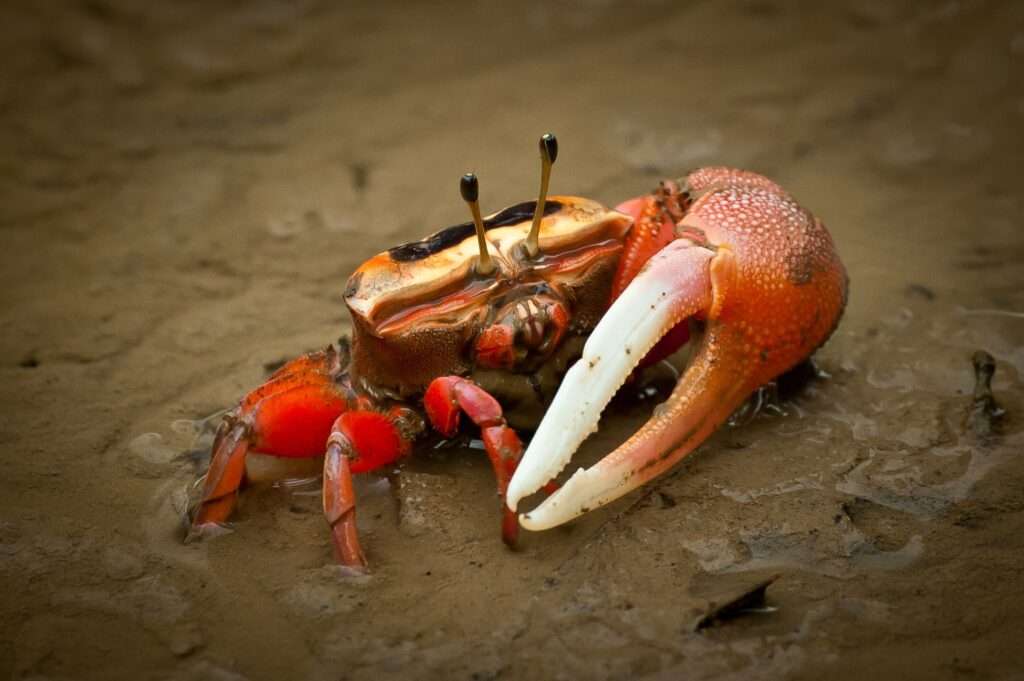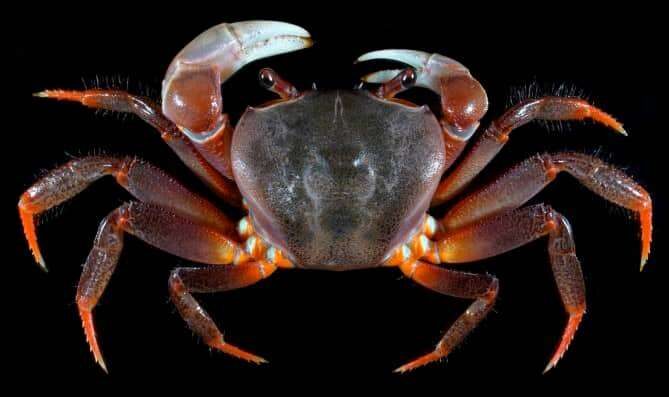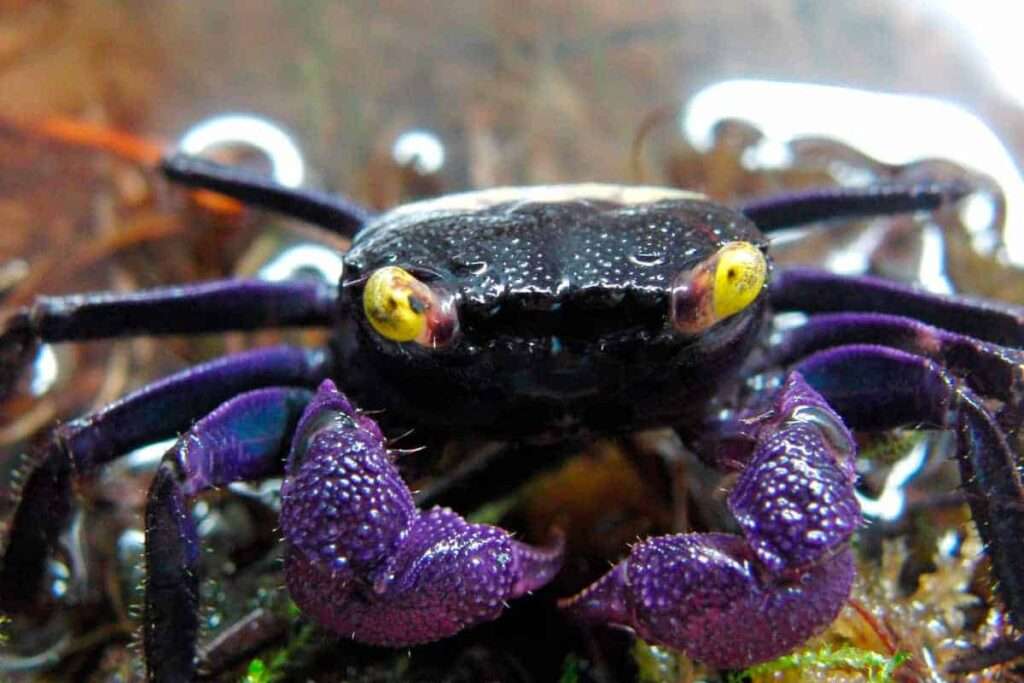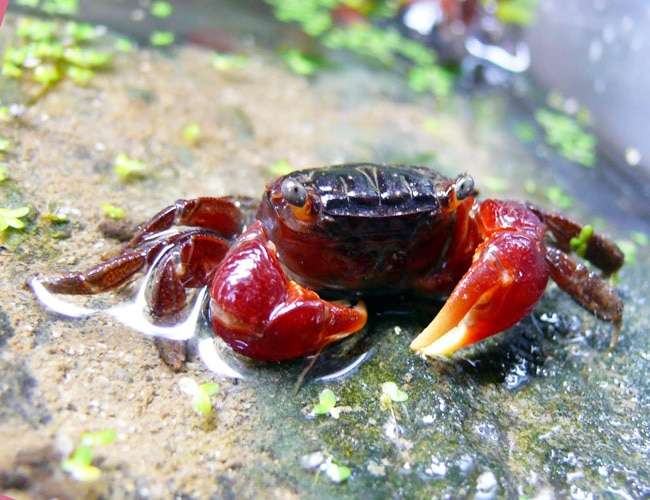
Small crustaceans known as fiddler crabs have an unusually expanded claw. They are found in the Chesapeake Bay on beaches, mud flats, and marshes.
A calling crab, also referred to as a fiddler crab, is one of the more than one hundred species of semi-terrestrial sea crabs in the Ocypodidae family. The family Ocypodidae also includes a few lesser-known species of ghost crab and mangrove crab. The largest of these bunch, which is made up entirely of little crabs, measures just over two inches (5 cm) in diameter. Fiddler crabs can be found in lagoons, swamps, brackish intertidal mud flats, seashores, and other salt- or brackish-water wetlands. The most distinctive feature of fiddler crabs is their sexually dimorphic claws; males have major claws that are significantly larger than minor claws, whilst females have claws that are equal in size.
Fiddler crabs shed their shells as they grow, just like all other crabs do. They will sprout new legs or claws when they molt if they lose any during their current growth cycle. Males will grow a new huge violin claw on the same side following their subsequent molt if the first one is removed. Because of their delicate shells, newly molted crabs are extremely vulnerable. They remain hidden until the new shell has time to harden.
Fiddler crabs display a consistent circadian cycle in a controlled laboratory environment that resembles the ebb and flow of the tides: they become dark during the day and light at night.
Appearance
Tan to brown is the range of colors for fiddler crabs. The lighter of the two species is the sand fiddler crab. Females have equal-sized claws; however, males have one larger claw that can grow to be 1.5 to 2 inches long. The shell has rounded rear margins and is square in shape. There is a groove behind each eye on the shell of the red-jointed fiddler crab. Male sand fiddler crabs have a blue or purplish shell, whereas male marsh fiddler crabs have a royal blue patch in the core of the carapace. Less than an inch broad to 1.5 inches wide are the sizes of shells. The red-jointed fiddler crab is the largest and the marsh fiddler crab is the smallest species found in the Bay area. There are four pairs of walking legs on fiddler crabs.
Feed
Algae, bacteria, and rotting marsh plants are all eaten by fiddler crabs. They hunt for food particles by sifting through mud or sand. To assist remove food from sand, they frequently dine in a watery puddle. Because both of a female’s claws are small, she has an advantage over a male in terms of finding and consuming food. Feeding is made more challenging by the mature male’s main claw.
Interesting Facts
- The most prevalent and widespread fiddler crab in the Bay area is the red-jointed fiddler crab.
- A fiddler crab’s species can be determined by looking at its expanded claw; the sand fiddler crab has a smooth underside. Red-jointed fiddler crabs have claws that are not smooth on the underside and have red joints. It is a marsh fiddler crab if not.
- In muddy parts of wetlands, red-jointed and marsh fiddler crabs can be found. Low salinities are more tolerable to red-jointed fiddler crabs. Sand fiddler crabs can only feed on sediment particles of a specified size, hence they can only exist in sandy, salty, and brackish beaches and flats. They cannot survive in muddy areas.
- The male’s larger main claw serves largely to entice a mate and deter rivals rather than to defend against predators.
- A male’s remaining major claw enlarges to the same size as the missing one if it loses its major claw. The lesser claw is replaced by the growing new claw.
- Despite having a huge main claw on the male, fiddler crabs are not very harmful to handle. However, take caution because the claws are easily breakable.
Keeping as Pet

Housing
Fiddler crabs in captivity require brackish water and a dry land region in their aquariums to replicate their native environment. If you have one to four fiddler crabs, make sure you have at least a 10-gallon aquarium. Per extra crab, increase the tank capacity by 3 to 5 gallons. Crabs experience a lot of stress from being overcrowded, which can affect their health and make them aggressive. Because fiddler crabs can climb out of their tank if given the chance, make sure the tank has a lid that is both secure and ventilated (such a mesh screen).
To get rid of chlorine from the tank water, use an aquarium water conditioner, which is readily accessible at most pet stores. Add aquarium salt after that to simulate brackish conditions. There may be instructions on how to make brackish water on the package of aquarium salt. The basic guideline for fiddler crabs is to salt the water to a specific gravity of between 1.005 and 1.01 (a measurement for liquids that indicates whether an object will sink or float in them). A hydrometer, which is located in the fish area of many pet stores, can be used to determine the specific gravity of a given specimen.
Grooming
Fiddler crabs molt, or shed their exoskeleton and develop a new one, to essentially groom themselves. A crab may slow down and lose its appetite before molting, and during molting it may look to be rather lifeless. That is typical. When a crab is molting, which might take several weeks, do not bother it. During this period, crabs are particularly vulnerable because their new exoskeleton needs to solidify before it can provide protection. A week should pass before removing the old exoskeleton from the tank because your crab may have consumed some of it for added calcium. When they molt, fiddler crabs can also grow new legs or claws.
Table





